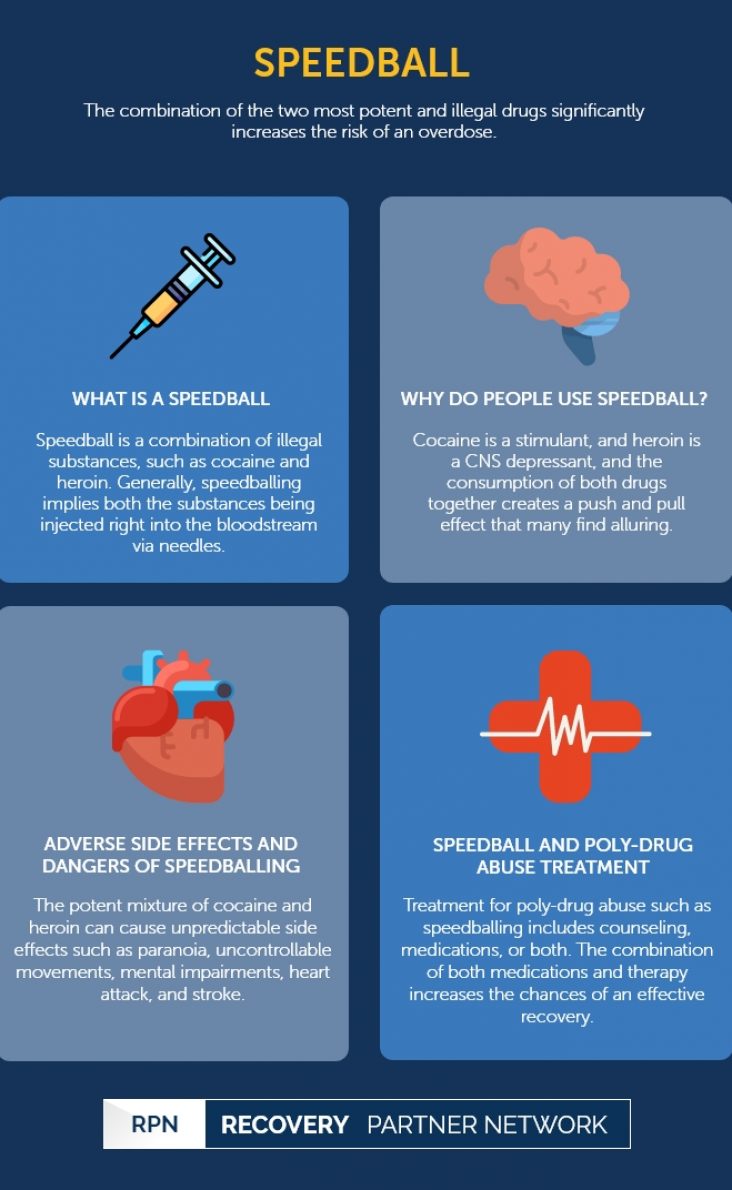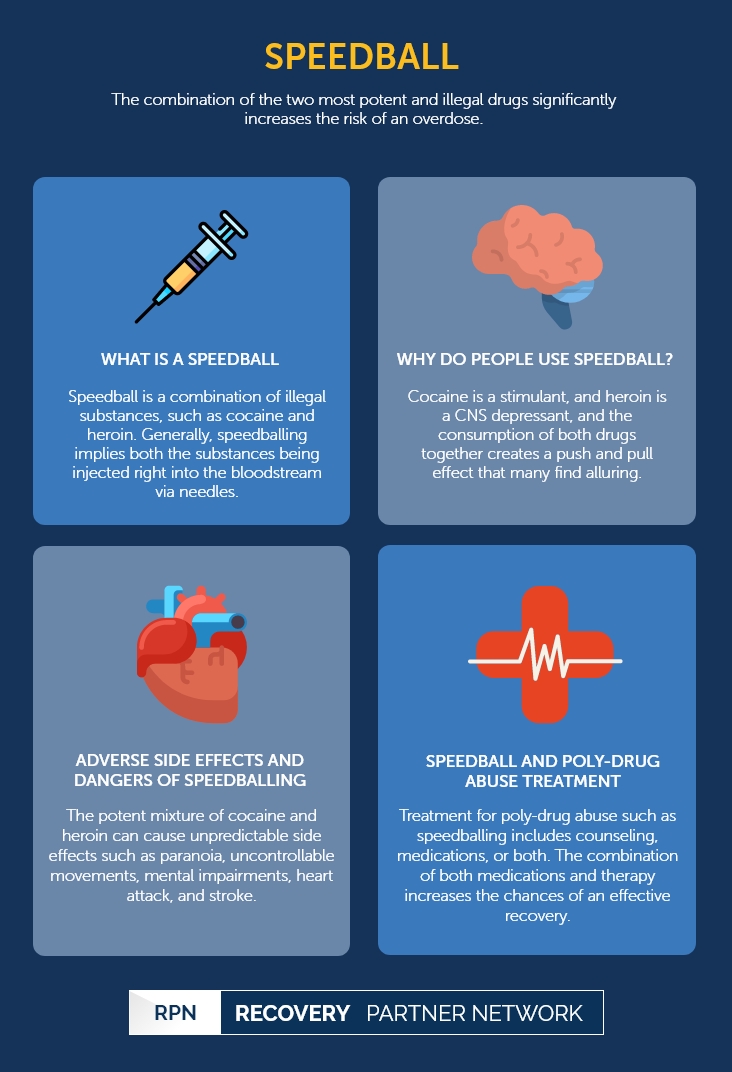The combination of the two most potent and illegal drugs significantly increases the risk of an overdose.
Speedball
Illicit drugs
- Ayahuasca addiction – Abuse
- Baclofen addiction
- Black tar heroin addiction
- Cannabis addiction
- Cocaine dependence
- Crack cocaine addiction
- DMT addiction abuse treatment
- Does Marijuana Kill Brain Cells?
- Ecstasy addiction
- Gabapentin addiction
- gamma-Hydroxybutyric acid addiction
- Hallucinogen
- Heroin addiction
- Illicit drug addiction
- Inhalant addiction
- Cocaine
- Ketamine addiction
- Lysergic acid diethylamide addiction
- Mescaline addiction
- Methamphetamine addiction
- Meth Labs: Cooking up Addiction
- Meth Mouth
- Microdosing
- Phencyclidine addiction
- Psilocybin mushroom addiction
- Sage of the diviners – Addiction
- Shooting Heroin
- Shooting Methamphetamine
- Smoking Cannabis
- Speedball
- Synthetic cannabinoids
Speedball | Table of Contents
What is Speedball?
Speedball is a combination of illegal substances, such as cocaine and heroin. Generally, speedballing implies both the substances being injected right into the bloodstream via needles. However, they can also be snorted nasally. Speedballs tend to generate a more powerful, longer-lasting high in comparison to consuming the drug individually.
Heroin is an illicit opioid (derived from morphine) that inhibits breathing and causes respiratory failure when combined with other depressants, such as alcohol. Cocaine is a stimulant that has almost the inverse effects of heroin (such as increased heart rate and rapid breathing.) It is a widespread misconception that mixing heroin with cocaine will either manage or cancel the negative side effects of heroin. However, mixing these substances is more harmful than using them individually since their negative effects can be amplified when combined.
FAQ
- How is a speedball consumed?
- What are the side effects of speedball?
- What are the symptoms of speedball overdose?
Speedballs are usually injected into the bloodstream or snorted.
The side effects of speedballing include paranoia, blurred vision, insomnia, drowsiness, confusion, impaired motor skills, and coordination.
A few symptoms of a speedball overdose are heart attack, aneurysm, respiratory failure, and stroke.
Why Do People Use Speedball?
Cocaine is a stimulant, and heroin is a CNS depressant, and the consumption of both drugs together creates a push and pull effect that many find alluring. Heroin in speedballing is intended to alleviate cocaine-induced agitation and jitters. On the other hand, cocaine is intended to lessen some of the sedative effects of heroin. Users claim that this balancing act leads to a more pleasurable high and comfortable comedown.
Adverse Side Effects and Dangers of Speedballing
The side effects traditionally attributed to cocaine are anxiety, hypersensitivity to vision, sound, touch, high blood pressure, and abnormal or rapid heartbeat. Opioids, such as heroin, are often associated with drowsiness and a decreased breathing rate. Once combined, the side effects of speedballing can affect the brain adversely. The potent mixture of cocaine and heroin can cause unpredictable side effects.
A few side effects of speedballing are:
- Confusion
- Blurred vision
- Drowsiness
- Paranoia
- Mental impairment as a result of poor sleep
- Uncontrollable movements
- Incoherence
- Stupor
Long-term side effects of speedballing can also manifest on the body’s main organs, including the lungs, heart, and liver. Reports are also available regarding individuals who experienced manic episodes, paranoia, or depression after speedballing. This method of drug use has also been linked to a higher risk of causing death.
Few of the potentially fatal side effects are:
- Stroke
- Heart attack
- Aneurysm
- Respiratory failure
Additional Risks and Speedball-Related Overdose
The risk of respiratory failure is even greater while speedballing, mainly due to the variations in how long cocaine and heroin impact the body. The euphoric effects of cocaine wean out quicker than heroin, and when this occurs, the body is overcome by the respiratory-impairing effects of heroin. Additionally, the combination of cocaine and heroin can enhance the effects of each, often resulting in an overdose.
In 2014, cocaine was the cause of the second largest number of overdose deaths. Since then, the use of cocaine has increased each year. This rise comes immediately after a steady decline in cocaine-related overdoses between 2005 and 2009. Statistics from county coroner’s studies indicate that poly-drug use was the cause of this spike.
Beginning with the second wave of the opioid epidemic, the emergence of illicitly produced fentanyl (a synthetic opioid that is a hundred times more potent than morphine and fifty times more potent than heroin) created a dramatic increase in overdose deaths. Although some individuals intentionally consume fentanyl for its lethal and powerful properties, most were genuinely unaware of fentanyl’s involvement in counterfeit drugs (such as oxycodone) and heroin. As a result, opioid-related deaths escalated.
The mixture of cocaine ( at high purity) and fentanyl were responsible for 1,542 deaths in 2015. Some researchers claim that the real number of fatalities is probably much higher due to the lack of fatal drug use records in certain counties.
Factors That Influence the Impact of Speedball
Several factors determine how the combination and the use of heroin and cocaine affect the body. An individual can use the same amount of drugs on different occasions and experience different effects each time.
Some of the factors that influence the impact of speedball may include:
- The purity of the drugs
- Drug dosage
- Frequency of use
- Whether it was cut or mixed with other drugs
- Method of administration
- The environment in which the drugs are consumed
- The user’s medical history, physical and psychological condition
- Mood
Speedball Statistics
- In 2015, around 63% of cocaine-related overdose deaths involved opioids, particularly heroin.
- Fentanyl-related deaths in Florida, which involved cocaine, rose to 42 percent (up from 17 percent) by the first half of 2015.
Speedball and Poly-drug Abuse Treatment
Treatment for poly-drug abuse such as speedballing includes counseling, medications, or both. Evidence shows that the combination of both medications and therapy significantly increases their chances of an effective recovery.
While medications generally help patients manage withdrawal symptoms, some are able to help patients regain natural brain activity and reduce their cravings. The therapies provided by these treatment programs can involve individual, family, and group therapy.
Therapy can help an individual in many ways:
- Educating a patient on their addiction.
- Enlightening a patient on their personal and behavioral changes since drug abuse.
- Helping a patient better manage triggers by teaching them coping skills.
- Teaching patients relapse prevention techniques.
Due to the life-threatening impact of speedball withdrawal, patients are highly advised to seek professional and medical assistance during detoxification.
Recovery Partner Network
We aim to educate and empower. If you feel our library of resources does not cover your specific need, reach out to us, and we would be happy to help.
STATISTICS
© Copyright 2025


